
US History lesson on New Immigration during the Industrial Age.
- Subject:
- U.S. History
- Material Type:
- Lesson
- Author:
- Andrew Dean
- Date Added:
- 10/23/2023

US History lesson on New Immigration during the Industrial Age.

Problems in nuclear engineering often involve applying knowledge from many disciplines simultaneously in achieving satisfactory solutions. The course will focus on understanding the complete nuclear reactor system including the balance of plant, support systems and resulting interdependencies affecting the overall safety of the plant and regulatory oversight. Both the Seabrook and Pilgrim nuclear plant simulators will be used as part of the educational experience to provide as realistic as possible understanding of nuclear power systems short of being at the reactor.

This is the first semester of a one-year graduate course in number theory covering standard topics in algebraic and analytic number theory. At various points in the course, we will make reference to material from other branches of mathematics, including topology, complex analysis, representation theory, and algebraic geometry.
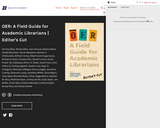
We intend this book to act as a guide writ large for would-be champions of OER, that anyone—called to action by the example set by our chapter authors—might serve as guides themselves. The following chapters tap into the deep experience of practitioners who represent a meaningful cross section of higher education institutions in North America. It is our hope that the examples and discussions presented by our authors will facilitate connections among practitioners, foster the development of best practices for OER adoption and creation, and more importantly, lay a foundation for novel, educational excellence.
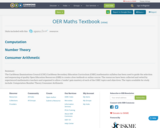
The Caribbean Examinations Council (CXC) Caribbean Secondary Education Curriculum (CSEC) mathematics syllabus has been used to guide the selection and sequencing of quality Open Education Resources (OER) to create a free textbook or online course. The resources have been collected and vetted by experienced mathematics teachers and organised to allow a 'reader' gain mastery of each of the CSEC topics and objectives. The topics available for study include:
Computation
Number Theory
Consumer Arithmetic

Developing a course, and associated materials, to support professional development can often be a costly enterprise. Designers and developers need to consider curriculum design, materials development, quality assurance, platform customisation and evaluation. Following this process step by step is often protracted and costly. The ADDIE model of instructional design, a popular and often cited ideal approach to creating courseware, suggests that analysis of needs, courseware design and development, implementation and course evaluation is required by any entity bent on creating effective courses.
In contrast to this mindset, however, there is evidence that a collaborative-shared approach to instructional design challenges the ADDIE model’s assumption that each step needs to be done in-house. Since 2011, several Teacher ICT Integration professional development initiatives around the globe have demonstrated that burdens in both design and development phases can be shared, shortening the time required to design courses and develop the accompanying resources. This approach also is more cost effective than typical ventures.

The Open Logic Text is an open textbook on mathematical logic aimed at a non-mathematical audience, intended for advanced logic courses as taught in many philosophy departments. It is open-source: you can download the LaTeX code. It is open: you’re free to change it whichever way you like, and share your changes. It is collaborative: a team of people is working on it, using the GitHub platform, and we welcome contributions and feedback. And it is written with configurability in mind.
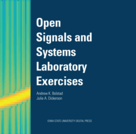
Open Signals and Systems Laboratory Exercises is a collection of lab assignments that have been used in EE 224: Signals and Systems I in the Department of Electrical and Computer Engineering at Iowa State University. These lab exercises have been curated, edited, and presented in a consistent format to improve student learning.

OpenStax Principles of Management test bank questions to supplement the instructor materials provided by OpenStax.

This is a supplementary video to support the Commonwealth of Learning's Open Textbook Manual. It shows you how to use the OER Commons Open Author Tool to create Open Textbooks.

Osbornictis piscivora: Information
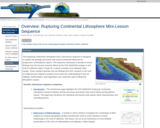
An examination of two contrasting rifted margins: the Red Sea and Gulf of California, leading to identification of similarities and differences associated with rifting and lithospheric rupture in each setting.

This extract from Ovid's 'Theban History' recounts the confrontation of Pentheus, king of Thebes, with his divine cousin, Bacchus, the god of wine. Notwithstanding the warnings of the seer Tiresias and the cautionary tale of a character Acoetes (perhaps Bacchus in disguise), who tells of how the god once transformed a group of blasphemous sailors into dolphins, Pentheus refuses to acknowledge the divinity of Bacchus or allow his worship at Thebes. Enraged, yet curious to witness the orgiastic rites of the nascent cult, Pentheus conceals himself in a grove on Mt. Cithaeron near the locus of the ceremonies. But in the course of the rites he is spotted by the female participants who rush upon him in a delusional frenzy, his mother and sisters in the vanguard, and tear him limb from limb.
The episode abounds in themes of abiding interest, not least the clash between the authoritarian personality of Pentheus, who embodies 'law and order', masculine prowess, and the martial ethos of his city, and Bacchus, a somewhat effeminate god of orgiastic excess, who revels in the delusional and the deceptive, the transgression of boundaries, and the blurring of gender distinctions.
This course book offers a wide-ranging introduction, the original Latin text, study aids with vocabulary, and an extensive commentary. Designed to stretch and stimulate readers, Gildenhard and Zissos's incisive commentary will be of particular interest to students of Latin at AS and undergraduate level. It extends beyond detailed linguistic analysis to encourage critical engagement with Ovid's poetry and discussion of the most recent scholarly thought.

Ovis vignei: Information

This course is an 8 Module:Introductory study of critical thinking and logic, with emphasis on argumentation, rhetoric, andproblem-solving.Examination of language, meaning, definition, fallacies, and arguments as theyoccur in academic and real-world settings (with an emphasis on online communication, media,and digital environments).Application of logic and critical thinking strategies to contemporaryissues and practical problem solving.

This course is an 8 Module:Investigation of ethical problems and solutions in contemporary business practice.Examination ethical theories and how to correctly use ethical decision-making frameworks to resolve issues dealing with personal, social, environmental, and corporate responsibility.Analysis of topics including personal morality in profit-oriented enterprises; codes of ethics; obligations to employees and other stakeholders; truth in advertising; whistleblowing and company loyalty; self and government regulation; the logic and future of capitalism; the changing responsibilities of the manager; and the need for awareness of social justice in management and business activities.
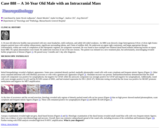
(This case study was added to OER Commons as one of a batch of over 700. It has relevant information which may include medical imagery, lab results, and history where relevant. A link to the final diagnosis can be found at the end of the case study for review. The first paragraph of the case study -- typically, but not always the clinical presentation -- is provided below.)
A 34 year-old otherwise healthy man presented with new onset headaches, mild confusion, and subtle left-sided weakness. An MRI scan showed a large heterogeneous 8.9cm x 6.0cm right fronto-temporo-parietal mass with nodular enhancement, significant surrounding edema, and 15mm of midline shift. He underwent an urgent right craniotomy, and began appropriate therapy. Unfortunately, within one week of completion of this therapeutic regimen, his symptoms worsened. He was found to have multiple new bilateral dural-based nodular enhancing lesions on repeat brain MRI. No spinal abnormalities were found. He underwent resection of one of the new lesions. The patient was initiated on a new treatment plan, but unfortunately, neuroimaging revealed further progression of disease (Figure 1). He passed away 5 months and 1 day after diagnosis.

(This case study was added to OER Commons as one of a batch of over 700. It has relevant information which may include medical imagery, lab results, and history where relevant. A link to the final diagnosis can be found at the end of the case study for review. The first paragraph of the case study -- typically, but not always the clinical presentation -- is provided below.)
The patient was a 37-year-old African American woman with a history of poorly treated HIV infection, diagnosed in 2001, with progression to AIDS. A recent CD4 count showed 7 cells / cubic millimeter with a viral load of 745,000 copies / milliliter. She presented to the emergency department with fever up to 102.3 degrees Fahrenheit and a cough productive of yellow sputum with no hemoptysis. She denied any recent weight loss. She denied ever having a positive PPD, but could not remember when she was last tested. She had been admitted 6 months previously for similar symptoms, and all cultures were negative except for the stool, which was positive for non-tuberculous mycobacteria.

(This case study was added to OER Commons as one of a batch of over 700. It has relevant information which may include medical imagery, lab results, and history where relevant. A link to the final diagnosis can be found at the end of the case study for review. The first paragraph of the case study -- typically, but not always the clinical presentation -- is provided below.)
A 45-year-old woman presented to our institution with progressive upper and lower extremity proximal weakness of a few weeks' duration. 3 months prior, the patient received a diagnosis of systemic lupus erythematosus and started on hydroxychloroquine; she had been treated with low dose prednisone for her weakness for the last 3 weeks. Physical examination showed severe proximal weakness, grade 2/5, in the bilateral upper and lower extremities with retained strength in all other muscle groups. The patient had an erythematous rash on her face, chest, and upper back. There was no clinical evidence of involvement of other organs.

(This case study was added to OER Commons as one of a batch of over 700. It has relevant information which may include medical imagery, lab results, and history where relevant. A link to the final diagnosis can be found at the end of the case study for review. The first paragraph of the case study -- typically, but not always the clinical presentation -- is provided below.)
This 4-year-old girl presented to the emergency department complaining of fever and pain in the lower extremities with refusal to bear weight. On four occasions a hip x-ray was performed, and she was sent home with pain medications. No laboratory studies were performed. She presented again with the above symptoms and weight loss (weight 13.8 kg, <10th percentile for age.) She was admitted and worked up for possible malignancy. Laboratory studies including a bone marrow biopsy were performed.